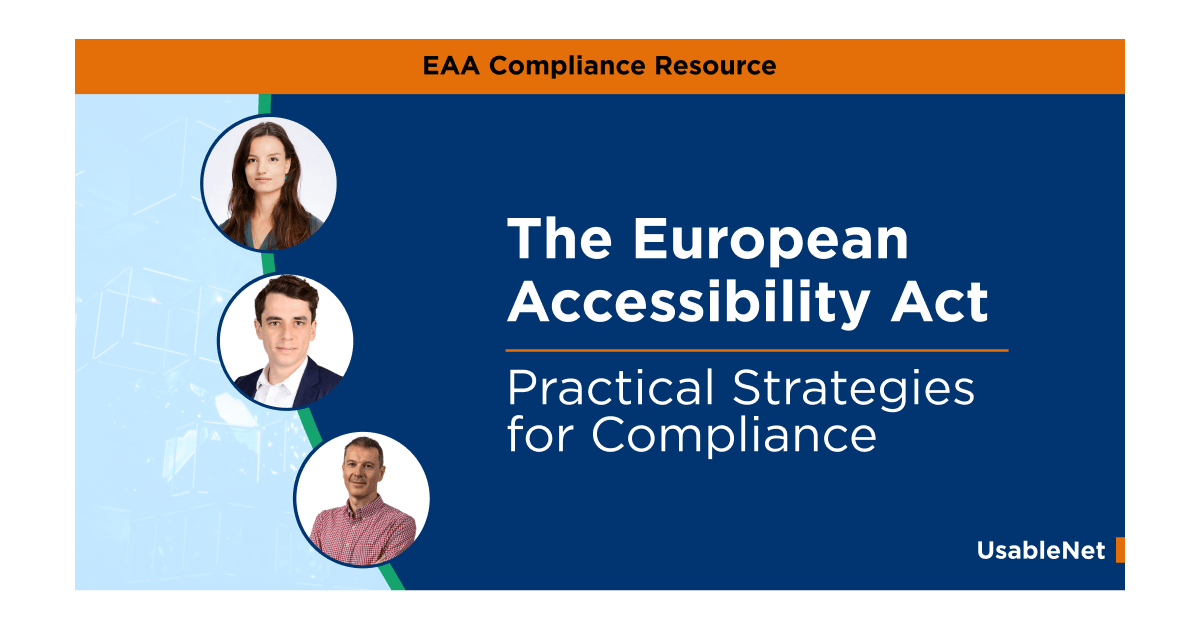Comply with EAA/EN 301 549 standards to ensure your digital platforms are accessible to all. This standard is a critical component of digital accessibility across the European Union (EU). The European Accessibility Act (EAA) deadline is June 28, 2025, and public and private sector organizations must meet these requirements.
Closely aligned with WCAG 2.1 AA, EN 301 549 sets comprehensive guidelines for a wide range of ICT products and services, helping businesses create inclusive digital experiences for everyone, regardless of ability.
To see how EN 301 549 fits within the broader EAA framework, visit our EAA guide.
As the EAA accessibility compliance deadline approaches, understanding how EAA/EN 301 549 differs from and complements other global accessibility guidelines, like WCAG, is vital for businesses aiming to stay compliant and avoid legal or financial repercussions.
What Is EN 301 549?
EN 301 549 is the European standard for ICT accessibility. Originally developed to ensure that public-sector websites and apps were accessible, this standard now applies to many private-sector services. It outlines precise requirements for websites, mobile apps, and other digital products to be accessible to people with disabilities.
A key aspect of EN 301 549 accessibility requirements is that they mirror much of WCAG 2.1 AA, the global standard for web accessibility, but extend to cover additional areas like biometrics and hardware accessibility, such as ATMs, payment terminals, and ticketing machines.
By following these guidelines, companies can ensure their digital products meet the needs of a wide range of users, including those who rely on assistive technologies such as screen readers and keyboard navigation.
If you’re preparing for EAA compliance, you’ll need to understand how EN 301 549 fits into the broader framework. Learn more about the EAA milestones in our blog on key EAA compliance milestones
Understanding WCAG vs. EN 301 549: What's the Difference?
Many businesses wonder how EN 301 549 differs from WCAG. While the two share common ground—particularly in web accessibility—EN 301 549 is broader.
- WCAG 2.1 AA focuses on websites and mobile apps, outlining criteria for making web content accessible.
- EN 301 549, however, incorporates these criteria and expands to cover other ICT products, including hardware such as e-readers, telecommunications equipment, and biometrics like facial recognition systems.
EN 301 549 is a comprehensive standard for organizations operating in the EU, especially for businesses in sectors like banking, telecommunications, and retail, which must consider their digital and physical services.
Why EAA/EN 301 549 Accessibility Requirements Matter
The importance of EN 301 549 accessibility requirements cannot be overstated, especially for businesses facing the June 2025 compliance deadline under the EAA. Here's why these standards matter:
- Legal Compliance: Non-compliance with EAA/EN 301 549 can result in severe penalties, including fines, removal from the EU market, or exclusion from public procurement processes. For companies operating in multiple European countries, compliance with this standard ensures alignment with a unified set of accessibility regulations, reducing the risk of legal action.
- Inclusive Customer Experience: The core goal of EN 301 549 is to remove barriers for people with disabilities, ensuring they can access digital services as easily as everyone else. By following these accessibility requirements, businesses can offer a more inclusive experience, improving customer satisfaction and loyalty.
- Competitive Advantage: With accessibility becoming increasingly important, businesses prioritizing compliance with EAA/EN 301 549 can stand out from competitors. Offering accessible services can attract a broader audience, including the estimated 135 million people with disabilities living in Europe.
Looking for guidance on managing the costs associated with compliance? Explore our blog on cost-effective EAA compliance strategies
Steps to Meet EN 301 549 Requirements
Navigating EAA/EN 301 549 compliance might seem daunting, but it doesn't have to be. Here are key steps to ensure your business is on the right track:
- Audit Your Current Status: Conduct a thorough digital service audit to identify accessibility gaps. This includes understanding WCAG 2.1 AA criteria and the additional requirements covered by EN 301 549, such as hardware accessibility.
- Use a Mix of Testing Methods: Automated tools are a great starting point, but more is needed. Combine them with manual and user testing by individuals with disabilities to catch issues that automated tests might miss.
- Update Regularly: Compliance is not a one-time effort. Regular audits and updates to your website, apps, and other digital products are necessary to stay aligned with evolving standards and user needs.
- Train Your Team: Ensure that all team members, from developers to customer service, understand the importance of accessibility and are trained to uphold EAA/EN 301 549 accessibility requirements.
For more strategies on compliance, particularly around balancing testing methods, check out our guide to balancing automated and manual testing for EAA compliance
Final Thoughts: Go Beyond Compliance
The role of EAA/EN 301 549 is crucial for digital accessibility in the EU. Join our European Accessibility Act (EAA) webinar to learn how this standard fits into EAA compliance and what steps your business should take to prepare. Register now and stay ahead of the 2025 deadline.








